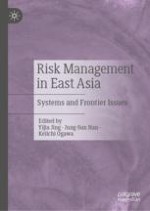2021 | OriginalPaper | Chapter
6. Participation Willingness and Interactive Strategy in Collaborative Risk Governance
Authors : Chun-yuan Wang, Yanyi Chang
Published in: Risk Management in East Asia
Publisher: Springer Singapore
Activate our intelligent search to find suitable subject content or patents.
Select sections of text to find matching patents with Artificial Intelligence. powered by
Select sections of text to find additional relevant content using AI-assisted search. powered by
